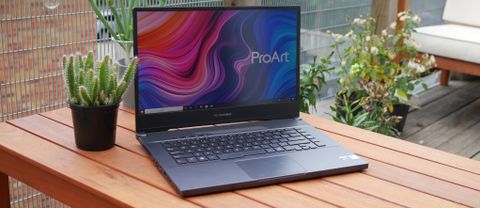Laptop Mag Verdict
Asus's ProArt StudioBook 15 is an excellent value for content creators but only if they don't need long battery life or a Thunderbolt 3 port.
Pros
- +
Fantastic 4K matte display
- +
Stylish, lightweight design
- +
Fast overall performance
- +
Competitively priced
Cons
- -
Lacks a Thunderbolt 3 port
- -
Poor battery life
- -
Runs warm
- -
No webcam
Why you can trust Laptop Mag
Price: $1,999
CPU: Intel Core i7-9750H
GPU: Nvidia GeForce RTX 2060
RAM: 32GB
Storage: 1TB SSD (dual 512GB SSD)
Display: 15.6 inches, 4K resolution
Battery: 3:21
Size: 14.2 x 9.9 x 0.8 inches
Weight: 4.4 pounds
The fight to win the hearts of so-called "content creators" has intensified in recent years with Apple and Dell taking the lead. But don't count out Asus; The company created an entire fleet of laptops under the ProArt branding to entice photo and video editors. The ProArt StudioBook Pro W700G3T, a 17-inch model we reviewed last year, was a promising start. Now, with the ProArt StudioBook 15 (priced at $1,999), Asus gives customers a compelling 15-inch option.
The sleek laptop delivers outstanding performance thanks to its Core i7 CPU, 32GB of RAM and RTX 2060 GPU. It also has a gorgeous 4K panel that can compete with the best of them. Unfortunately, there are a few frustrating omissions and troubling drawbacks you should be aware of before purchasing the ProArt StudioBook 15. Because of these, the ProArt StudioBook 15 narrowly misses its chance at being among the best 15-inch laptops.
Asus ProArt StudioBook 15 price and configuration options
The ProArt StudioBook 15 is a pretty good value. The unit we reviewed, and the only config available right now, costs $1,999 and comes with a 15.6-inch, 4K display, a Core i7-9750H CPU, 32GB of RAM, 1TB of storage split between two 512GB SSDs, and an Nvidia GeForce RTX 2060 GPU with 6GB of vRAM.
Asus sells a related model called the ProArt StudioBook 15 Pro for $3,999. This beast also has a 15.6-inch, 4K display but packs a Core i7-9750H CPU, 48GB of RAM (!), two 2TB SSDs and an Nvidia Quadro RTX 5000 GPU.
Asus ProArt StudioBook 15 design
I wish I could give Asus a call the next time my wardrobe needs a makeover. This company knows style. It's apparent in the sleek designs of its laptops and unique colorways not offered by rivals.
The ProArt StudioBook 15 is a more conservative example of what the creative folks at Asus can craft, but it's befitting of its purpose as a stylish workhorse for content creators. There are some swanky accents to the StudioBook, starting with the signature brushed metal finish on the lid. It's always worth emphasizing the color of Asus' laptops, in this case, gunmetal gray with a hint of purple in certain lighting. Also on the lid is a stylus reflective Asus logo.
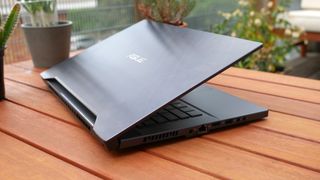
On the bottom of the lid is a trapezoidal cutdown framing three LED indicators on the deck of the laptop. These show your battery status, Wi-Fi connection and power state. Just below those are diagonal slits for improved airflow and four keys (play, pause, next, power button) separated above the keyboard. Sharp lines and aggressive angles are found throughout the chassis, giving the ProArt a sleek, modern appearance.
It's also practical. The display is bordered on three sides by miniscule bezels and there is a lip on the front of the deck for opening the lid (which can be done with one hand). I also really like the subtle texture on the magnesium-alloy deck and how it resists fingerprints (unlike the lid).
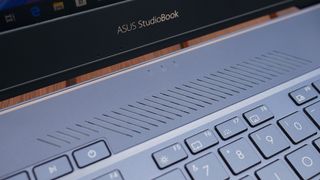
This is a thin and lightweight laptop for the amount of power it delivers (more on that later). At 14.2 x 9.9 x 0.8 inches and 4.4 pounds, the ProArt StudioBook 15 is about the same size as the Dell XPS 15 (0.7 inches, 4.5 pounds), lighter than the Razer Blade 15 (0.8 inches, 5 pounds) but heavier and thicker than the Microsoft Surface Laptop 3 (0.6 inches, 3.4 pounds).
Asus ProArt StudioBook 15 ports
Here lies a grave error. The lack of a Thunderbolt 3 port on the ProArt StudioBook 15 is an inexplicable omission. I'll humor Microsoft's bizarre reason for avoiding the latest connectivity standard but Asus has no excuse.
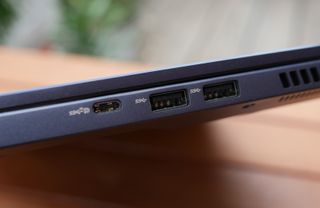
As a consolation, the ProArt StudioBook 15 has a single USB-C port on the right side that supports DisplayPort for 4K output. Next to it are two USB 3.1 Type-A ports for connecting legacy peripherals (mice, keyboards, webcams, etc) and a lock slot.
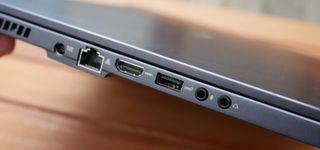
On the left side of the laptop is a DC-in power port, an RJ-45 Ethernet port, an HDMI 2.0 input, a third USB 3.1 Type-A port and dedicated headphone and mic jacks.
Asus ProArt StudioBook 15 display
The 15.6-inch, 4K display on the StudioBook 15 is fantastic. The detailed panel has rich, accurate colors and the matte finish prevents reflections from getting in the way as you edit photos or videos.

I watched a trailer for The King's Man while sitting on my patio on a bright day and had no problems seeing the threads in Harris Dickenson's knitted sweater or individual crystal balls hanging from a ballroom chandelier.
A car explosion at a parade scene sent fireballs of radiant orange and yellow into the air, which contrasted against the turquoise uniforms of the unfortunate officers wearing them. You'll get punchier colors from a quality glossy screen but this is among the most colorful matte displays I've tested.
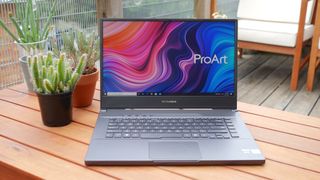
According to our colorimeter, the StudioBook 15's display covers an outstanding 171% of the sRGB color gamut, making it much more vivid than the screens on the XPS 15 (132%), the Blade 15 (107%) and the Surface Laptop 3 (101%). The category average for premium laptops is only 121%.
- Laptops with the Most Colorful Screens: 2020 Guide
As is typically the case with Asus laptops, I wish the ProArt's display got a bit brighter. The maximum brightness of 339 nits is decent, but the panels on the XPS 15 (434 nits), the Surface Laptop 3 (380 nits) and the average premium laptop (368 nits) outshone the StudioBook 15. For what it's worth, the Blade 15 has a disappointingly dim display (275 nits). Despite not getting as bright as competitors, I had no problems viewing the screen outside on a sunny day thanks to its effective matte finish.
Asus ProArt StudioBook 15 keyboard and touchpad
I've never been so torn about a keyboard. On one hand, I really like the key layout. The arrow keys are separated from the rest of the keyboard in an inverse T-shape, making them easy to find without looking.
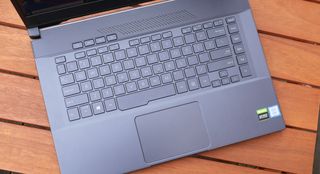
Four discrete shortcut keys for play/pause, next/previous, and the power button are positioned above the standard shortcut row. That row is divided into three sections with four keys each, one group for volume adjustment, another for display/keyboard controls and the last for utilities, like fan output and enable/disable the microphone.
I'm less enthusiastic about the keys themselves. They're not terrible, but there is a frail springiness to them that doesn't jive with me; I prefer keys with clicky, tactile feedback. Also, the actuation force, or the amount of finger muscle needed to initiate a keystroke, is a tad demanding.
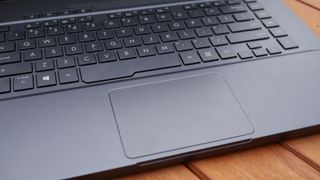
Regardless, I typed at 111 words per minute with an accuracy of 94% on the 10FastFingers.com typing test. That is slower and a bit less accurate than my 119-wpm at 95% accuracy averages, but decent nonetheless.
The 4.2 x 2.8-inch touchpad is a good one. It has a smooth surface and it didn't have any issues tracking my movements as I browsed the web and flicked my fingers to activate Windows 10 gestures, like two-finger scrolling or pinch-to-zoom. It's weird that the touchpad is centered and not aligned with the space bar, but that didn't cause too many problems, even when the fleshy part of my palm was accidentally swiping against it while my fingers were on home row.
Asus ProArt StudioBook 15 audio
The dual speakers underneath the ProArt Studio 15 captured a surprising amount of depth in the song "Stakes" by ZES. The calm vocals were relatively detailed and the aggressive synthesizer tones and low bass rumbles never blanketed them. Thankfully, the sharp violin-like treble didn't pierce my sensitive ears, even at maximum volume. These aren't the loudest speakers but they pump out enough sound to fill a small room.
Phoebe Bridgers' "Kyoto" also sounded balanced, with a weighty low range, but the vocals were somewhat hollow and the drums lacked crispness.
Asus ProArt StudioBook 15 performance
Equipped with an Intel Core i7-9750H CPU and 32GB of RAM, the ProArt StudioBook 15 sped right along as I live streamed a German soccer game with around 20 Google Chrome tabs running in the background. Pages loaded quickly and graphics appeared instantly as the laptop never stuttered no matter what I threw at it, which included four 1080p YouTube videos. I wasn't doing any intensive editing but tweaking some of the images in this review in Affinity Photo didn't bother the laptop one bit.
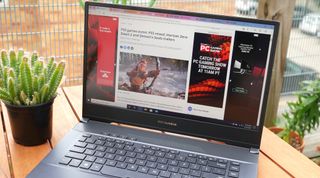
The ProArt StudioBook 15 did a great job keeping up with leaders in its category. On the Geekbench 5 test, which measures overall performance, it scored a 5,963, which crushes the Surface Laptop 3 (2,856, AMD Ryzen 5 3580U), the Blade 15 (4,918, Core i7-9750H) and the premium laptop average (Core i7-9750H, 4,249). Only the XPS 15 (6,174) with a 10th Gen Core i7-10750H, outmuscled the Asus.
Asus also outfitted the ProArt StudioBook 15 with some speedy storage. The dual 512GB SSDs (an M.2 and a PCIe NVMe) converted 5GB of multimedia files in 8.1 seconds for a transfer rate of 628.3 megabytes per second. Again, the XPS 15 (726 MBps) took the crown, but the Asus knocked out the Blade 15 (565.5 MBps), the Surface Laptop 3 (282.7 MBps) and nearly matched the premium average (686.6 MBps).
These laptops held their positions in our video transcoding test, which tasks them to convert a 4K video to 1080p resolution. The ProArt StudioBook 15 landed in second place with a time of 10:25, just behind the XPS 15 (10:06) but ahead of the Blade 15 (10:47), Surface Laptop 3 (20:33) and the category average (18:30).
On our new test, which measures Photoshop performance, the ProArt StudioBook scored a 713, which is only slightly behind the XPS 15 (787) but ahead of the average (591).
Asus ProArt StudioBook 15 graphics
Here is where things get interesting. The ProArt StudioBook 15 has an Nvidia GeForce RTX 2060 GPU with 6GB of vRAM. Its competitors, like the Dell XPS 15 (GTX 1650 Ti) and Blade 15 (GTX 1660 Ti), also use discrete graphics but none of them make the leap to RTX. The difference is significant, as you'll see in our benchmark scores.
The Asus laptop ran Shadow of the Tomb Raider (1080p, Highest) at 46 frames per second, crushing the XPS 15 (29 fps, GeForce GTX 1650 Ti Max-Q), although the Blade 15 (48 fps, GeForce GTX 1660 Ti) had an edge over the ProArt StudioBook 15.
We saw similar results on the GTA V (1080p, Very High) benchmark in which the ProArt StudioBook 15 played at a steady 63 fps. That nearly matches the Blade 15 (64 fps) and, once again, outplays the XPS 15 (42 fps).
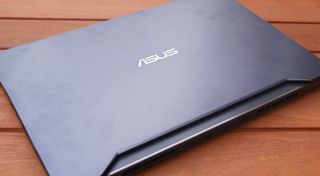
The ProArt StudioBook 15 consistently fell just a few frames shy of the Blade 15. In our Far Cry New Dawn benchmark, the ProArt hit 72 fps whereas the Blade 15 notched 77 fps. The XPS 15 (48 fps) isn't in the same league as these gaming-capable laptops.
You won't have much luck playing games at 4K resolution on the ProArt StudioBook 15. It mustered only 15 fps on the Shadow of the Tomb Raider test and a still-unplayable 19 fps in Assassin's Creed Odyssey. That said, less demanding titles, like Hitman (40 fsp), will run at 4K without much stuttering.
Asus ProArt StudioBook 15 battery life
4K display, Core i7 H-series CPU, portable chassis? It's a recipe for battery life disaster. Sure enough, the ProArt StudioBook 15 fell victim, lasting a measly 3 hours and 39 minutes on our battery test (continuous web surfing over Wi-Fi at 150 nits).
The XPS 15 with a 4K screen (8:01) and the Surface Laptop 3 (8:00) embarrassed the ProArt, enduring for more than double its runtime. The Blade 15 didn't excel in this test either but it at least got a few additional hours over the ProArt StudioBook 15. Keep in mind, however, that none of these competitors have an RTX GPU.
Asus ProArt StudioBook 15 webcam
I'm sorry, the file you were looking for is missing. Well, this is awkward...the StudioBook 15 doesn't have a webcam!
When Asus pulled this trick with some of its gaming laptops, there was a reason to back it up: gamers who stream need better quality than what an internal camera delivers. Fair enough. But on a laptop meant for content creators and enterprise users? Sorry, that excuse doesn't fly.
There is an obvious solution: buy one of these external webcams. I own our top pick, the Logitech C920, and have been happily using it 2.5 years.
Asus ProArt StudioBook 15 heat
I should try cooking an egg on the bottom panel of this laptop. In all seriousness, the ProArt StudioBook 15 gets pretty toasty when running a heavy workload. The bottom reached a scolding 107 degrees Fahrenheit and even the center of the keyboard (101 degrees) topped our 95-degree comfort threshold. This was after we ran a 15-minute full HD video in full screen, so consider buying a cooling pad if you want to use the ProArt for gaming.
Asus ProArt StudioBook 15 software and warranty
Asus did a good job of streamlining the utilities it offers into a few useful apps. MyAsus is the one you'll want to keep. This is where you can check for BIOS updates, adjust hardware (battery, fans, etc) settings and contact customer support.
Also on the ProArt StudioBook 15 is an AudioWizard app where you can tinker with the EQ or choose presets for when you're listening to music or watching movies.
Unfortunately, there are also some unwelcome apps, like McAfee, and your standard Windows 10 Pro fare, including Candy Crush Friends.
The ProArt StudioBook 15 comes with a one-year warranty. See how Asus did on our Best and Worst Brands and Tech Support Showdown special reports.
Bottom line
I really enjoyed using the ProArt StudioBook 15 to edit photos, watch videos and browse the web. It has a fantastic 4K display, blistering-fast performance, and a stylish design. I'm also impressed by the specs you get for $1,999 -- a Core i7-9750H CPU, 32GB of RAM, 1TB of fast storage and a GeForce RTX 2060 GPU.
But I can only recommend the ProArt StudioBook 15 as an alternative to the XPS 15 or MacBook Pro if you really don't care about battery life. Another letdown is the lack of a Thunderbolt 3 port, and the bottom of the laptop ran warm even when we weren't gaming. As a result, the XPS 15 remains a better all-around laptop.
Regardless, if you can see past some of its glaring faults, then the ProArt StudioBook 15 has a lot to offer for a pretty reasonable price.
Phillip Tracy is the assistant managing editor at Laptop Mag where he reviews laptops, phones and other gadgets while covering the latest industry news. After graduating with a journalism degree from the University of Texas at Austin, Phillip became a tech reporter at the Daily Dot. There, he wrote reviews for a range of gadgets and covered everything from social media trends to cybersecurity. Prior to that, he wrote for RCR Wireless News covering 5G and IoT. When he's not tinkering with devices, you can find Phillip playing video games, reading, traveling or watching soccer.
